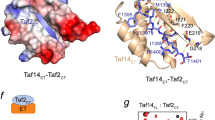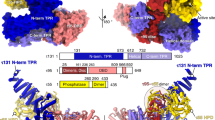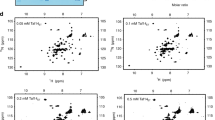Abstract
THE protein TFIID is a general transcription factor1 which initiates preinitiation complex assembly2–4 through direct interaction with the TATA promoter element5,6. It is a multisubunit complex containing a small TATA-binding polypeptide (TBP) and other TBP-associated factors (TAFs) ranging in size from about 30–250K (refs 7–10). Although native TFIID can mediate both activator-independent (basal) and activator-dependent transcription in reconstituted systems3,5,6, TBP itself can mediate only basal transcription11,12, even in cases where TBP or the general factor TFIIB are known to interact directly with transcriptional activators13–15. TFIID subunits other than TBP must therefore be essential cofactors, and thus potential targets for activators, consistent with earlier demonstrations that activators interact with TFIID (refs 3, 5, 16, 17). Here we show that the 250K subunit of TFIID is identical to a gene product previously implicated in progression through the late Gl phase of the cell cycle18,19. Part of p250 may thus serve a specific function in the activation of a subset of genes important for cell cycle progression.
This is a preview of subscription content, access via your institution
Access options
Subscribe to this journal
Receive 51 print issues and online access
$199.00 per year
only $3.90 per issue
Buy this article
- Purchase on Springer Link
- Instant access to full article PDF
Prices may be subject to local taxes which are calculated during checkout
Similar content being viewed by others
References
Matsui, T., Segall, J., Weil, P. A. & Roeder, R. G. J. biol. Chem. 255, 11992–11996 (1980).
Van Dyke, M. W., Roeder, R. G. & Sawadogo, M. Science 241, 1335–1338 (1988).
Horikoshi, M., Hai, T., Lin, Y.-S., Green, M. R. & Roeder, R. G. Cell 54, 1033–1042 (1988).
Buratowski, S., Hahn, S., Guarente, L. & Sharp, P. A. Cell 56, 549–561 (1989).
Sawadogo, M. & Roeder, R. G. Cell 43, 165–175 (1985).
Nakajima, N., Horikoshi, M. & Roeder, R. G. Molec. cell. Biol. 8, 4028–4040 (1988).
Dynlacht, B. D., Hoey, T. & Tjian, R. Cell 66, 563–576 (1991).
Tanese, N., Pugh, B. F. & Tjian, R. Genes Dev. 5, 2212–2224 (1991).
Takada, R. et al. Proc. natn. Acad. Sci. U.S.A. 89, 11809–11813 (1992).
Zhou, Q., Lieberman, P., M., Boyer, T. G. & Berk, A. Genes Dev. 6, 1964–1974 (1992).
Hoffmann, A. et al. Nature 346, 387–390 (1990).
Peterson, M. G., Tanese, N., Pugh, B. F. & Tjian, R. Science 248, 1625–1630 (1990).
Stringer, K. F., Ingles C. J. & Greenblatt, J. Nature 345, 783–786 (1990).
Lee, W. S., Kao, C. C., Bryant, G. O., Liu, X. & Berk, A. J. Cell 67, 365–376 (1991).
Lin, Y.-S. & Green, M. R. Cell 64, 971–981 (1991).
Horikoshi, M., Carey, M. F., Kakidani, H. & Roeder, R. G. Cell 54, 665–669 (1988).
Workman, J. M., Abmayr, S. M., Cromlish, W. A. & Roeder, R. G. Cell 55, 211–219 (1988).
Sekiguchi, T., Miyata, T. & Nishimoto, T. EMBO J. 7, 1683–1687 (1988).
Sekiguchi, T., Nohiro, Y., Nakamura, Y., Hisamoto, N. & Nishimoto, T. Molec. cell. Biol. 11, 3317–3325 (1991).
Nikolov, D. B. et al. Nature 360, 40–46 (1992).
Malik, S., Hisatake, K., Sumimoto, H., Horikoshi, M. & Roeder, R. G. Proc. natn. Acad Sci. U.S.A. 88, 9553–9557 (1991).
Tamkun, J. W. et al. Cell 68, 561–572 (1992).
Haynes, S. R., Dollard, C., Winston, F., Beck, S. & Dawid, I. Nucleic Acids Res. 20, 2603 (1992).
Georgakopoulos, T. & Thireos, G. EMBO J. 11, 4145–4152 (1992).
Bianchi, M. E., Falciola, L., Ferrari, S. & Lilley, D. M. J. EMBO J. 11, 1055–1063 (1992).
Ferrari, S. et al. EMBO J. 11, 4497–4506 (1992).
Helman, J. D. & Chamberlin, M. J. A. Rev. Biochem. 57, 839–872 (1988).
Johnston, L. H. Trends Cell Biol. 2, 353–357 (1992).
Schmid, R. M., Perkins, N. D., Duckett, C. S., Andrews, P. C. & Nabel, G. J. Nature 352, 733–736 (1991).
Liu et al. J. biol. Chem 260, 3269–3274 (1985).
Author information
Authors and Affiliations
Rights and permissions
About this article
Cite this article
Hisatake, K., Hasegawa, S., Takada, R. et al. The p250 subunit of native TATA box-binding factor TFIID is the cell-cycle regulatory protein CCG1. Nature 362, 179–181 (1993). https://doi.org/10.1038/362179a0
Received:
Accepted:
Issue Date:
DOI: https://doi.org/10.1038/362179a0
This article is cited by
-
Crystal structure of a TAF1-TAF7 complex in human transcription factor IID reveals a promoter binding module
Cell Research (2014)
-
Transactivation mediated by B-Myb is dependent on TAFII250
Oncogene (2003)
-
Cyclin D1 suppresses retinoblastoma protein-mediated inhibition of TAFII250 kinase activity
Oncogene (2000)
-
The cloning, mapping and expression of a novel gene, BRL, related to the AF10 leukaemia gene
Oncogene (1999)
-
Overexpression of D-type cyclins, E2F-1, SV40 large T antigen and HPV16 E7 rescue cell cycle arrest of tsBN462 cells caused by the CCG1/TAFII250 mutation
Oncogene (1999)
Comments
By submitting a comment you agree to abide by our Terms and Community Guidelines. If you find something abusive or that does not comply with our terms or guidelines please flag it as inappropriate.



